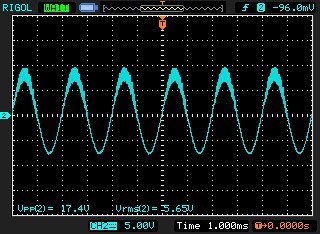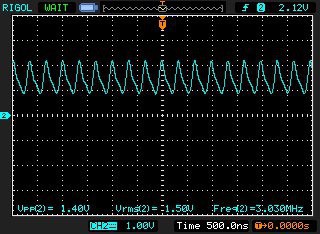I've found a cheap loudspeaker which I could use to test my amplifier. It is 8 Ohm/50W speaker, so not exactly what I designed my amp for, but it was cheap and worth trying out preliminary tests.
When I plugged it in, and powered the amp, I could see somethin weird. On top of my clean sinewave, there was some kind of parasitic hf signal, not seen before. When I zoomed in, I could see it is a 3MHz component.
 Zoom in on HF glitch:
Zoom in on HF glitch:
At first I was confused - where did this come from? Can the speaker introduce some resonance into the amp. Why is all of a sudden so instable.
Then I remembered that high frequency oscillations usually originate from low value parasitic L and C elements. And one serious parasitic capacitance between BJT base and collector usually contributes to the amplifier instabilities. As someone here on Hackaday said in comments, these kind of oscillations are preventale by the proper bias of the output stage. Indeed, when I turned the potentiometer, I could see the oscillations going away. Amazing!
Now, I plan to make a simple pre-amp to test some serious music on this loudspeaker.
 Pero
Pero
Discussions
Become a Hackaday.io Member
Create an account to leave a comment. Already have an account? Log In.